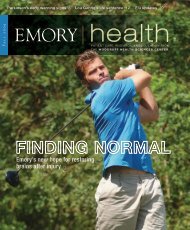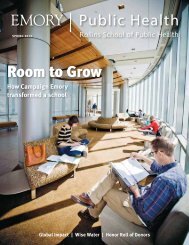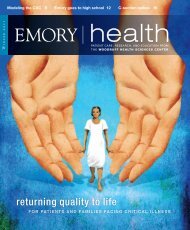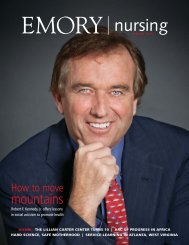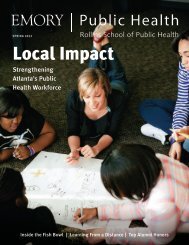extension - Woodruff Health Sciences Center - Emory University
extension - Woodruff Health Sciences Center - Emory University
extension - Woodruff Health Sciences Center - Emory University
You also want an ePaper? Increase the reach of your titles
YUMPU automatically turns print PDFs into web optimized ePapers that Google loves.
curriculum<br />
PRePa Pa P Ring foR<br />
tomorrow’s practice<br />
Want to know what the practice of physical therapy is going to look<br />
like tomorrow? Take a look at <strong>Emory</strong>’s DPT curriculum today.<br />
Faculty this year revamped <strong>Emory</strong>’s already strong<br />
DPT curriculum to better prepare its students for a<br />
changing clinical landscape. These changes include: the<br />
introduction of a complex of courses on health promo-<br />
tion, wellness and prevention; the expansion of<br />
offerings dealing with clinical diagnosis; and<br />
the enhancement of experiential learning<br />
opportunities.<br />
“We always try to inno- inno-<br />
vate,” says Zoher Kapasi,<br />
interim director of the<br />
<strong>Emory</strong> DPT Other new course offerings in the<br />
program.<br />
“We try not only to<br />
DPT’s revamped curriculum include:<br />
stay with the times,<br />
Principles of motor learning. formerly the<br />
but to project what<br />
domain of industrial psychology, the science behind the profession will be<br />
the process of acquiring new motor skills applies like in the future.”<br />
directly to the practice of physical therapy.<br />
Paralleling the<br />
health care system’s<br />
Exploration of human behavior. This course<br />
shift in focus toward<br />
focuses on patient empowerment and understandwellness<br />
and preing<br />
that patients will adhere to physical therapy<br />
vention, <strong>Emory</strong> has<br />
interventions if intervention goals are meaningful<br />
launched courses<br />
to them.<br />
in health promo-<br />
Bioengineering. in light of the increasing importion<br />
at both the<br />
tance of robotics in rehabilitation, this course famil- individual and<br />
iarizes students with basic bioengineering concepts.<br />
community levels.<br />
“This is an area<br />
into which physi-<br />
cal therapy can step<br />
nicely,” says Jeanne Charles, assistant<br />
professor. “The courses begin in the<br />
first year by focusing on how you can<br />
make yourself healthy and culminate<br />
in the third year with coverage of<br />
community health promotion and<br />
wellness.”<br />
The wellness offerings also dovetail<br />
with another trend in physical therapy<br />
– the advent of direct access. “In addi- addition<br />
to seeing people with musculosk-<br />
eletal and neurological problems, we<br />
will increasingly be the first point of<br />
4 EMORY | ExTENSiON | FALL 2010<br />
contact for people who are seeking health and wellness<br />
services,” says Brenda Greene, assistant professor.<br />
Direct access also necessitates improved diagnostic<br />
skills. Accordingly, <strong>Emory</strong> has added an advanced course<br />
in clinical diagnosis. “If you are in a direct access setting,<br />
you need to be able to understand those conditions that<br />
can be treated by you and those that need to be referred<br />
to a physician,” says Charles.<br />
Another exciting addition is a host of experiential<br />
learning opportunities through the <strong>Emory</strong> <strong>Center</strong> for Experiential<br />
Learning (ExCEL). At the Objective Structured<br />
Clinical Examination (OSCE) <strong>Center</strong>, trained actors present<br />
with a particular condition and students are asked to<br />
examine, assess and provide treatment. Afterwards, the<br />
actor gives feedback, and the student can also watch a<br />
video playback. “It’s a much more powerful learning experience<br />
to practice and receive feedback in a more ‘real<br />
life’ rather than classroom environment,” says Charles.<br />
ExCEL also offers a simulation lab, in which students<br />
can assess and treat a mannequin. The mannequins,<br />
which are equipped with high fidelity simulators,<br />
respond much like real humans to the performance of<br />
various procedures.<br />
“All of these changes are going to impact the DPT<br />
program in a very positive way,” says Charles. “We have<br />
adapted to changes in the physical therapy profession,<br />
and we’ll continue to evaluate our curriculum, projecting<br />
future patient and community needs.” e



